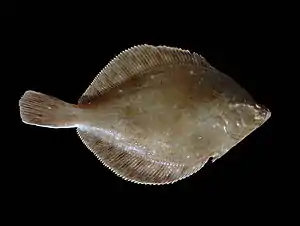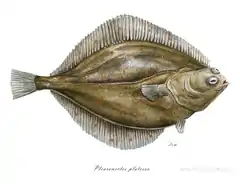European plaice
The European plaice (Pleuronectes platessa) is a commercially important flatfish.
| European plaice | |
|---|---|
 | |
| Scientific classification | |
| Kingdom: | Animalia |
| Phylum: | Chordata |
| Class: | Actinopterygii |
| Order: | Pleuronectiformes |
| Family: | Pleuronectidae |
| Genus: | Pleuronectes |
| Species: | P. platessa |
| Binomial name | |
| Pleuronectes platessa | |
| Synonyms[2] | |
Distribution and habitat
The geographical range of the European plaice is off all coasts from the Barents Sea to the Mediterranean, also in the Northeast Atlantic and off Greenland. In some locales such as the Irish Sea, this species is considered fully exploited by commercial fishing.[3]
It is a common flatfish, occurring on the sandy and muddy bottoms of the European shelf, usually at depths between 10 and 50 m, where it tends to burrow in sediment during day time and remain stationary for long periods. They can be found at depths to about 200 m. Young fish in particular come right inshore in very shallow water.
They are able to survive low salt concentrations and may occur in some cases in brackish or even in fresh water.
Description

The European plaice is characterised above by their dark green to dark brown skin, blotched with conspicuous, but irregularly distributed, orange spots. The underside is pearly white. The skin is smooth with small scales. They are able to adapt their colour somewhat to match that of their surroundings, but the orange spots always remain visible.[4] The skin lacks any prickles.
Its maximum length is about 1 m (3.3 ft), but adults, caught in fishing nets, are usually between 50 and 60 cm (20 and 24 in) in length. Its maximum published weight is 7 kg (15 lb) and its maximum recorded age is 50 years.[5]
The outline of adults is oval. The head is rather small and is less than 25% of the total length. The pointed mouth is terminal and fairly small with its maxilla reaching just below the right eye. Both eyes are located at the right side of the body. The bony ridge behind the eyes is another characteristic for this species. The lateral line curves slightly above the pectoral fin. The dorsal fin reaches the eye. The dorsal and anal fins are distant from the caudal fin. The anal fin contains 48 to 59 soft rays and is preceded by a spine. The dorsal fin has 65–79 soft rays, the pectoral fin 10 to 11, and the ventral fin six.[6]
Food
It is active at night and feeds on polychaetes, crustaceans and bivalves. Young plaice (between 1 and 2 years old) tend to consume mainly shrimps.
Lifecycle
The main spawning grounds in the North Sea are located in the Southern Bight and in the eastern English Channel. Plaice are determinate spawners in which fecundity is determined before the onset of spawning. Females mature, i.e. are able to spawn, at ages from 3 to 7 years. However, in the North Sea, most females mature at 3 years. Ovary development begins around late August to September with the spawning being from December to May. Each female releases eggs in batches every 3 to 5 days for around a month.
The eggs hatch after about two weeks and drift passively in the plankton. The larvae drift in the plankton and metamorphose after about 8 to 10 weeks, dependent on temperature, at which time they settle in the intertidal zone of sandy beaches. The larvae exhibit what is sometimes called semiactive tidal transport. As the larvae cannot swim against the prevailing currents, they make use of their ability to alter their vertical position in the water column to ensure they are transported to suitable habitat. On incoming or flood tides (water level is rising), the larvae move up into the water column and are thus transported towards land. On the outgoing or ebb tides (water level is falling), the larvae move down the water column and are not transported away from the intertidal by the tidal currents.
When the larvae have reached a suitable site for settlement, the metamorphosis to the asymmetric body shape takes place. This can take up to 10 days.
Recently transformed juveniles settle onto shallow intertidal beaches. The very youngest juveniles will, for a period of up to a week, strand themselves in very shallow pools on the intertidal once the tide has receded. The reasons for this behaviour are not clear. During the first year of life (when the fish are called 0+ group), the juveniles will stay in these shallow intertidal habitats for up to 7 months (depending on latitude and/or temperature), before migrating to deeper waters. Some of these fish will return the next year (when they are I+ group) and even fewer when they are II+ group; however, the majority of juveniles do not return after they have migrated during their first year.
As a food

Plaice is sometimes used as the fish in fish and chips, in countries where the dish is popular.[7]
In North German and Danish cuisine, plaice is one of the most commonly eaten fishes. Filleted, battered, and pan-fried plaice is popular hot or cold as an open sandwich topping together with remoulade sauce and lemon slices. Battered plaice can also be served hot with french fries and remoulade sauce as a main dish; this fish and chips variant is commonly available as a children's special in Danish restaurants. Breaded frozen plaice, ready to be baked or fried at home, is readily available in supermarkets. Fresh plaice is also oven-baked.
Threats
Plaice, along with the other major demersal fish in the North Sea such as cod, monkfish, and sole, is listed by the ICES as "outside safe biological limits." Moreover, they are growing less quickly now and are rarely older than six years, whereas they can reach 40.[8] The World Wildlife Fund says, in 2006, "of the eight plaice stocks recognised by ICES, only one is considered to be harvested sustainably while three are overexploited. Data are insufficient to assess the remaining stocks; however, landings for all stocks are at or near historical lows."[9]
In 2010, Greenpeace International has added the European plaice to its seafood red list.[10]
References
- Freyhof, J. (2014). "Pleuronectes platessa". IUCN Red List of Threatened Species. 2014: e.T135690A50018800. doi:10.2305/IUCN.UK.2014-1.RLTS.T135690A50018800.en. Downloaded on 25 March 2018
- Froese, Rainer and Pauly, Daniel, eds. (2018). "Plueronectes platessa" in FishBase. February 2018 version.
- Hogan, C. Michael (2011). Irish Sea. eds. P.Saundry & C.Cleveland. Encyclopedia of Earth. National Council for Science and the Environment. Washington DC Archived June 2, 2013, at the Wayback Machine
- Picton, B.E. (2007). Encyclopedia of Marine Life of Britain and Ireland.
- Muus, B. J.; Dahlström, P. (1974). Collins guide to the sea fishes of Britain and North-Western Europe. London: Collins. ISBN 0-00-212058-5.
- P.J. Hayward, J. S. Ryland (1996). Handbook of the Marine Fauna of North-West Europe. Oxford University Press. p. 756. ISBN 0-19-854055-8.
- Seafish. On Plate. Fish & chips Archived October 11, 2008, at the Wayback Machine
- Clover, Charles (2004). The End of the Line: How overfishing is changing the world and what we eat. London: Ebury Press. ISBN 0-09-189780-7.
- "European plaice and sole".
- "Greenpeace International Seafood Red list". Archived from the original on April 10, 2010.
- Cooper, J.A. and F. Chapleau (1998). Monophyly and intrarelationships of the family Pleuronectidae (Pleuronectiformes), with a revised classification. Fish. Bull., U.S. 96(4):686-726.
- "Pleuronectes platessa". Integrated Taxonomic Information System. Retrieved 30 January 2006.
- Rijnsdorp, A.D. (1991). Changes in fecundity of female North Sea plaice (Pleuronectes platessa) between three periods since 1900. ICES Journal of Marine Science 48:253-280.
- Wimpenny, R.S. (1953). The plaice being the buckland lectures. Publisher Edward Arnold.
- Gibson, R.N. (2004). Flatfishes: Biology and Exploitation. Blackwell Publishing.
External links
| Wikimedia Commons has media related to Pleuronectes platessa. |
- Guide to Responsible Sourcing of Plaice - produced by Seafish https://web.archive.org/web/20071008001434/http://www.seafish.org/upload/file/fisheries_management/Plaice%20Factsheet2%20%20final.pdf
- Information about plaice
- Froese, Rainer and Pauly, Daniel, eds. (2008). "Pleuronectes Platessa" in FishBase. October 2008 version.
- Photos of European plaice on Sealife Collection
